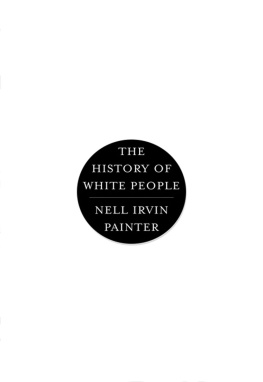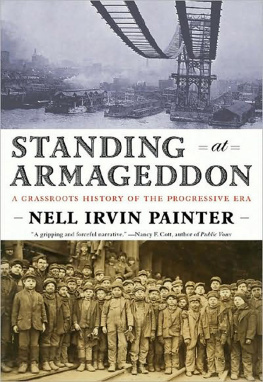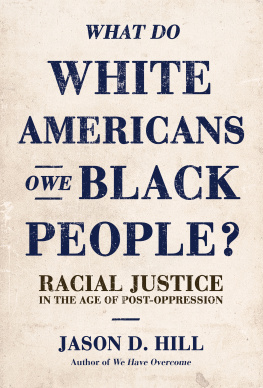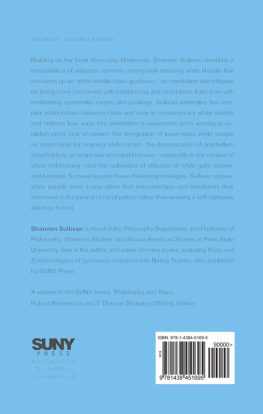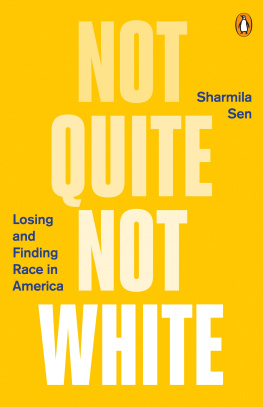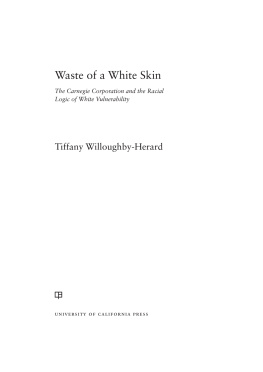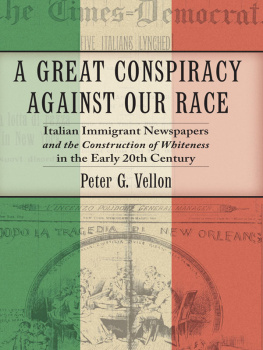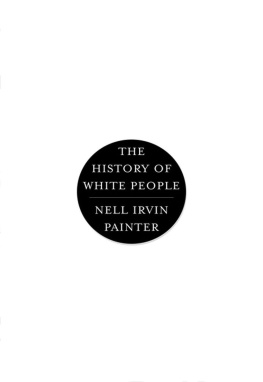W. W. NORTON & COMPANY
Painter, Nell Irvin.
The history of White people / Nell Irvin Painter.
p. cm.
1. WhitesRace identityUnited States.
2. WhitesUnited StatesHistory.
3. United StatesRace relations. I. Title.
W. W. Norton & Company, Inc.
500 Fifth Avenue, New York, N.Y. 10110
www.wwnorton.com
W. W. Norton & Company Ltd.
Castle House, 75/76 Wells Street, London W1T 3QT
INTRODUCTION
I might have entitled this book Constructions of White Americans from Antiquity to the Present , because it explores a concept that lies within a history of events. I have chosen this strategy because race is an idea, not a fact, and its questions demand answers from the conceptual rather than the factual realm. American history offers up a large bounty of commentary on what it means to be nonwhite, moving easily between alternations in the meaning of race as color, from colored to Negro to Afro-American to black to African American, always associating the idea of blackness with slavery. But little attention has been paid to historys equally confused and flexible discourses on the white races and the old, old slave trade from eastern Europe.
I use white races in the plural, because for most of the past centurieswhen race really came down to matters of laweducated Americans firmly believed in the existence of more than one European race. It is possible, and important, to investigate that other side of history without trivializing the history we already know so well.
Let me state categorically that while this is not history in white versus black, I do not by any means underestimate or ignore the overwhelming importance of black race in America. I am familiar with the truly gigantic literature that explains the meaning, importance, and honest-to-god reality of the existence of race when it means black. In comparison with this preoccupation, statutory and biological definitions of white race remain notoriously vaguethe leavings of what is not black. But this vagueness does not indicate lack of interestquite to the contrary, for another vast historical literature, much less known today, explains the meaning, importance, and honest-to-god reality of the existence of white races.
It may seem odd to begin a book on Americans in antiquity, a period long before Europeans discovered the Western Hemisphere and thousands of years before the invention of the concept of race. But given the prevalence of the notion that race is permanent, many believe it possible to trace something recognizable as the white race back more than two thousand years. In addition, not a few Westerners have attempted to racialize antiquity, making ancient history into white race history and classics into a lily-white field complete with pictures of blond ancient Greeks. Transforming the ancients into Anglo-Saxon ancestors made classics unwelcoming to African American classicists. The blond-ancient-Greek narrative may no longer be taught in schools, but it lives on as a myth to be confronted in these pages. Before launching the trip back to ancient times, however, it may be useful to make a few remarks about the role of science or science of race.
I resist the temptation to place the word scienceeven theories and assertions of the most spurious, pernicious, or ridiculous kindin quotation marks, for the task of deciding what is sound science and what is cultural fantasy would quickly become all-consuming. Better to note the qualifications of yesterdays scientists than to brand as mere science their thought that has not stood the test of time. I give scholars of repute in their day pride of place in my pagesno matter that some of their thinking has fallen by the wayside.
T ODAY WE think of race as a matter of biology, but a second thought reminds us that the meanings of race quickly spill out of merely physical categories. Even in so circumscribed a place as one book, the meanings of white race reach into concepts of labor, gender, and class and images of personal beauty that seldom appear in analyses of race. Work plays a central part in race talk, because the people who do the work are likely to be figured as inherently deserving the toil and poverty of laboring status. It is still assumed, wrongly, that slavery anywhere in the world must rest on a foundation of racial difference. Time and again, the better classes have concluded that those people deserve their lot; it must be something within them that puts them at the bottom. In modern times, we recognize this kind of reasoning as it relates to black race, but in other times the same logic was applied to people who were white, especially when they were impoverished immigrants seeking work.
Those at the very bottom were slaves. Slavery has helped construct concepts of white race in two contradictory ways. First, American tradition equates whiteness with freedom while consigning blackness to slavery. The history of unfree white people slumbers in popular forgetfulness, though white slavery (like black slavery) moved people around and mixed up human genes on a massive scale. The important demographic role of the various slave trades is all too often overlooked as a historical force. In the second place, the term Caucasian as a designation for white people originates in concepts of beauty related to the white slave trade from eastern Europe, and whiteness remains embedded in visions of beauty found in art history and popular culture.
Today most Americans envision whiteness as racially indivisible, though ethnically divided; this is the scheme anthropologists laid out in the mid-twentieth century. By this reckoning, there were only three real races (Mongoloid, Negroid, and Caucasoid) but countless ethnicities. Today, however, biologists and geneticists (not to mention literary critics) no longer believe in the physical existence of racesthough they recognize the continuing power of racism (the belief that races exist, and that some are better than others). It took some two centuries to reach this conclusion, after countless racial schemes had spun out countless different numbers of races, even of white races, and attempts at classification produced frustration.
Although science today denies race any standing as objective truth, and the U.S. census faces taxonomic meltdown, many Americans cling to race as the unschooled cling to superstition. So long as racial discrimination remains a fact of life and statistics can be arranged to support racial difference, the American belief in races will endure. But confronted with the actually existing American populationits distribution of wealth, power, and beautythe notion of American whiteness will continue to evolve, as it has since the creation of the American Republic.

